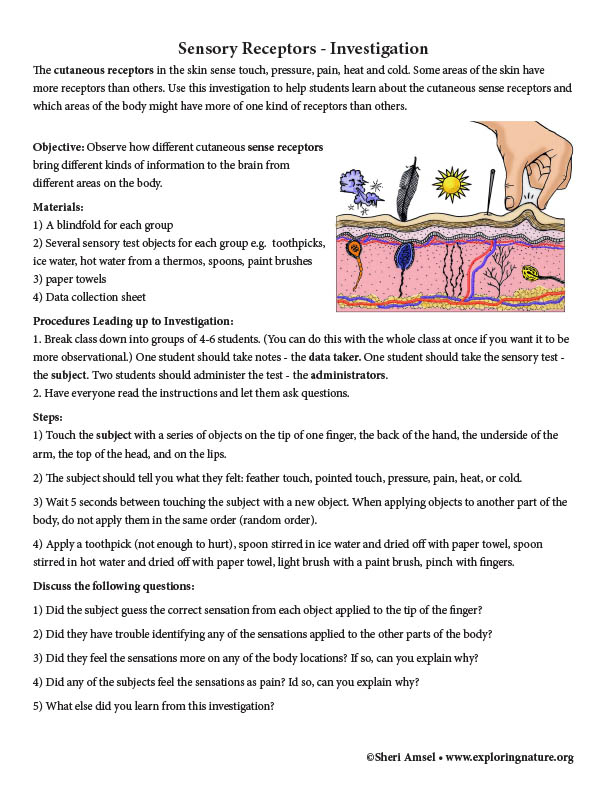

The cutaneous receptors in the skin sense touch, pressure, pain, heat and cold. Some areas of the skin have more receptors than others. Use this investigation to help students learn about the cutaneous sense receptors and which areas of the body might have more of one kind of receptors than others.
Objective: Observe how different cutaneous sense receptors
bring different kinds of information to the brain from
different areas on the body.
Materials:
1) A blindfold for each group
2) Several sensory test objects for each group e.g. toothpicks,
ice water, hot water from a thermos, spoons, paint brushes
3) paper towels
4) Data collection sheet
Procedures Leading up to Investigation:
1. Break class down into groups of 4-6 students. (You can do this with the whole class at once if you want it to be more observational.) One student should take notes - the data taker. One student should take the sensory test - the subject. Two students should administer the test - the administrators.
2. Have everyone read the instructions and let them ask questions.
Steps:
1) Touch the subject with a series of objects on the tip of one finger, the back of the hand, the underside of the arm, the top of the head, and on the lips.
2) The subject should tell you what they felt: feather touch, pointed touch, pressure, pain, heat, or cold.
3) Wait 5 seconds between touching the subject with a new object. When applying objects to another part of the body, do not apply them in the same order (random order).
4) Apply a toothpick (not enough to hurt), spoon stirred in ice water and dried off with paper towel, spoon stirred in hot water and dried off with paper towel, light brush with a paint brush, pinch with fingers.
Discuss the following questions:
1) Did the subject guess the correct sensation from each object applied to the tip of the finger?
2) Did they have trouble identifying any of the sensations applied to the other parts of the body?
3) Did they feel the sensations more on any of the body locations? If so, can you explain why?
4) Did any of the subjects feel the sensations as pain? Id so, can you explain why?
5) What else did you learn from this investigation?
When you research information you must cite the reference. Citing for websites is different from citing from books, magazines and periodicals. The style of citing shown here is from the MLA Style Citations (Modern Language Association).
When citing a WEBSITE the general format is as follows.
Author Last Name, First Name(s). "Title: Subtitle of Part of Web Page, if appropriate." Title: Subtitle: Section of Page if appropriate. Sponsoring/Publishing Agency, If Given. Additional significant descriptive information. Date of Electronic Publication or other Date, such as Last Updated. Day Month Year of access < URL >.
Amsel, Sheri. "Sensory Receptors - Investigation (6-8 Grade NGSS)" Exploring Nature Educational Resource ©2005-2024. December 14, 2024
< http://www.exploringnature.org/db/view/Sensory-Receptors-Investigation-6-8-Grade-NGSS >
